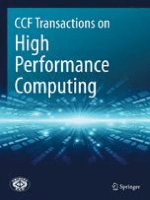
CCF Transactions on High Performance Computing
Scope & Guideline
Transforming Computational Practices through Rigorous Research
Introduction
Aims and Scopes
- High-Performance Computing Architectures:
Research on the design and optimization of hardware architectures that enable high-performance computing, including CPU, GPU, and specialized processors. - Programming Models and Software Development:
Exploration of new programming models, languages, and tools that facilitate the development of software for HPC applications, including parallel and distributed computing paradigms. - Algorithm Development and Optimization:
Focus on innovative algorithms that enhance computational performance, including numerical methods, machine learning algorithms, and optimization techniques. - Heterogeneous Computing Systems:
Studies on the integration of various computing resources, such as CPUs, GPUs, FPGAs, and accelerators, to achieve efficient performance in complex computational tasks. - Benchmarking and Performance Evaluation:
Methodologies for assessing the performance of HPC systems and applications through rigorous benchmarking and analysis. - Applications of HPC in Science and Industry:
Research that highlights the application of high-performance computing in various domains, including computational science, engineering, and data-intensive applications.
Trending and Emerging
- AI and Machine Learning Integration:
Recent works show a significant rise in exploring how AI and machine learning can enhance HPC applications, particularly in optimizing performance and resource management. - Heterogeneous and Specialized Architectures:
There is a growing emphasis on research involving heterogeneous computing systems that combine various processing units, such as CPUs, GPUs, and FPGAs, to maximize performance. - Cloud Computing and Edge Computing:
A trend towards utilizing cloud resources and edge computing frameworks for HPC applications is evident, focusing on scalability, flexibility, and resource optimization. - Sustainability and Energy Efficiency in HPC:
Increasing attention is being paid to developing energy-efficient algorithms and architectures, addressing the environmental impact of high-performance computing. - Advanced Benchmarking Techniques:
Emerging methodologies for benchmarking and performance evaluation, particularly in heterogeneous environments, are gaining traction, highlighting the need for more nuanced performance metrics.
Declining or Waning
- Traditional Parallel Computing Techniques:
There has been a noticeable shift away from traditional parallel computing techniques towards more sophisticated methods involving heterogeneous and specialized computing architectures. - Basic Theoretical Studies:
Research focused solely on theoretical aspects of high-performance computing without practical applications or implementations is becoming less frequent, as the emphasis shifts towards applied and experimental studies. - General-purpose Computing on GPUs:
While GPU computing remains vital, there is a decrease in publications centered on general-purpose applications, with a growing preference for tailored solutions that leverage specific architectures or frameworks.
Similar Journals
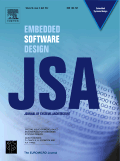
JOURNAL OF SYSTEMS ARCHITECTURE
Advancing Knowledge in Systems DesignJOURNAL OF SYSTEMS ARCHITECTURE is a prestigious academic journal published by ELSEVIER, based in the Netherlands, that has established itself as a leading platform for research in the fields of Hardware and Architecture and Software. With an impressive impact factor and ranked in the Q1 category for both computer science sectors, this journal is recognized for its high-quality contributions, evidenced by its Scopus ranking of #32 in Hardware and Architecture and #74 in Software, placing it in the top percentiles of its field. The journal spans a wide range of topics central to systems architecture, focusing on innovative research that advances the understanding of computer systems and promotes future developments. Researchers, professionals, and students alike will find invaluable insights and emerging trends that address the challenges and opportunities within the rapidly evolving field of systems design and architecture. Spanning from 1996 to 2024, the JOURNAL OF SYSTEMS ARCHITECTURE continues to be a vital resource for those seeking to stay at the forefront of technology and research.
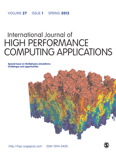
INTERNATIONAL JOURNAL OF HIGH PERFORMANCE COMPUTING APPLICATIONS
Connecting Scholars to the Future of Computing ApplicationsThe INTERNATIONAL JOURNAL OF HIGH PERFORMANCE COMPUTING APPLICATIONS, published by SAGE PUBLICATIONS LTD, is a leading academic journal dedicated to the advancement of high-performance computing in various domains, including hardware, software, and theoretical frameworks. With a strong commitment to disseminating innovative research since its inception in 1987, the journal plays a pivotal role in bridging the gap between theoretical advancements and practical applications in computing. Featuring an impressive impact across its categories—ranked Q2 in Hardware and Architecture, Software, and Theoretical Computer Science—this journal appeals to a diverse audience of researchers and professionals seeking to explore the latest developments and applications in high-performance computing. The journal is accessible via various open access options, ensuring that cutting-edge research is available to a wide readership, fostering collaboration and knowledge-sharing within the global computing community. Scholars interested in pushing the boundaries of technology and its applications will find this journal an invaluable resource as it continues to evolve towards its projected convergence years, extending its influence through 2024 and beyond.

Frontiers of Computer Science
Advancing the Boundaries of Computational InnovationFrontiers of Computer Science is a leading peer-reviewed journal dedicated to advancing the field of computer science through the publication of high-quality research articles, reviews, and theoretical discussions. Published by HIGHER EDUCATION PRESS, this journal has gained significant recognition, currently boasting a prestigious impact factor and ranking in the Q1 quartile for both Computer Science (miscellaneous) and Theoretical Computer Science categories in 2023. With a focus on the intersection of computational theory and practical applications, it serves as a vital platform for researchers, professionals, and students alike who are eager to contribute to and stay updated with groundbreaking developments. The journal’s scope encompasses a wide range of topics, reflecting the diverse nature of computer science today. Operating from Beijing, China, it emphasizes Open Access, ensuring that vital research is readily available to the global academic community. With its convergence period spanning from 2013 to 2024, Frontiers of Computer Science remains committed to fostering innovation and scholarly dialogue that drives the future of technology.
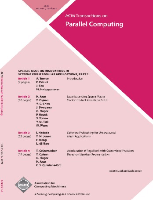
ACM Transactions on Parallel Computing
Driving Progress in Parallel and Distributed TechnologiesACM Transactions on Parallel Computing (ISSN: 2329-4949; E-ISSN: 2329-4957), published by the Association for Computing Machinery, stands as a pivotal journal in the field of computer science, particularly focusing on the advancements in parallel and distributed computing. With its convergence years spanning from 2014 to 2024, this journal serves as a significant platform for disseminating cutting-edge research, methodologies, and technologies that shape the future of computational theory, hardware architectures, and effective software solutions. Although it currently holds a Q3 category ranking in various subfields including Computational Theory and Mathematics, and Modeling and Simulation, it continues to attract researchers aiming to contribute to its growing impact in the field. The journal's commitment to fostering knowledge exchange makes it an essential resource for professionals and students eager to navigate the complexities of parallel computing. As the field evolves, ACM Transactions on Parallel Computing remains a critical reference point for innovative research and professional development in computer science.

Communications on Applied Mathematics and Computation
Pioneering Research for a Dynamic Mathematical FutureCommunications on Applied Mathematics and Computation is a distinguished journal published by SpringerNature, dedicated to advancing the fields of Applied Mathematics and Computational Mathematics. With its ISSN 2096-6385 and E-ISSN 2661-8893, the journal has established itself as a critical platform for researchers seeking to disseminate their findings and engage with contemporary mathematical challenges. Recognized in the Q2 quartile of both Applied Mathematics and Computational Mathematics categories for 2023, it ranks impressively within its field, holding the 278th position in a pool of 635 journals for Applied Mathematics and the 89th out of 189 for Computational Mathematics, indicative of its scholarly impact. The journal facilitates open access to a plethora of pioneering research, promoting collaboration and innovation in a global academic community. With a commitment to high-quality publications from 2019 through 2024, Communications on Applied Mathematics and Computation serves as an essential resource for scholars and practitioners aiming to bridge theory and practical applications in mathematics.

International Journal of Networked and Distributed Computing
Connecting Ideas, Transforming TechnologiesWelcome to the International Journal of Networked and Distributed Computing, published by SpringerNature, a premier outlet for cutting-edge research in the realms of computer networks and distributed computing systems. Established as an Open Access journal since 2013 and based in the Netherlands, this publication strives to disseminate high-quality, peer-reviewed studies that address the complexities of contemporary computing challenges. With an impact factor that reflects its growing influence—positioned in the Q3 category for both Computer Networks and Communications and Computer Science Applications—this journal serves as a pivotal resource for scholars and practitioners aiming to advance knowledge and innovation in this rapidly evolving field. The journal encompasses diverse topics, from network protocols to distributed algorithms, ensuring that researchers, professionals, and students can find relevant insights and methodologies to inform their work. Join us in exploring the depths of networked and distributed computing, contributing to a collaborative academic environment that shapes the future of technology.
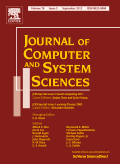
JOURNAL OF COMPUTER AND SYSTEM SCIENCES
Unveiling groundbreaking discoveries in computing and systems.The Journal of Computer and System Sciences is a distinguished publication founded in 1967 and continually striving to push the boundaries of knowledge in computer science and applied mathematics. Published by Academic Press Inc, Elsevier Science, this journal boasts impressive credentials, holding a Q1 quartile ranking across multiple categories including Applied Mathematics, Computational Theory and Mathematics, Computer Networks and Communications, and Theoretical Computer Science as of 2023. With a focus on innovative research and comprehensive theoretical developments, this journal serves as a pivotal forum for authors and readers alike, facilitating cutting-edge contributions to the field. The journal is not currently open access, providing a curated selection of high-quality articles for its subscription residents. By engaging with this journal, researchers, professionals, and students can gain insight into the latest trends, prominent methodologies, and significant findings that shape the modern landscape of computing and systems analysis.
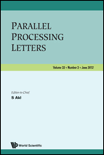
Parallel Processing Letters
Catalyzing Discussions in Parallel Processing Dynamics.Parallel Processing Letters is a notable academic journal published by World Scientific Publishing Co Pte Ltd, focusing on the dynamic fields of Computer Science, particularly in Hardware and Architecture, Software, and Theoretical Computer Science. Established in 1994, this journal provides a platform for the dissemination of cutting-edge research and developments in parallel processing and computational technologies. Despite its current Q4 ranking in multiple categories, Parallel Processing Letters plays an important role in fostering scholarly discussion and innovation within the computing community. With the ISSN 0129-6264 and E-ISSN 1793-642X, the journal is dedicated to maintaining rigorous academic standards while encouraging collaborative research conducive to the advancement of parallel processing systems. It serves as a valuable resource for researchers, professionals, and students seeking to deepen their understanding and gain insights into this rapidly evolving domain.

INTERNATIONAL JOURNAL OF PARALLEL PROGRAMMING
Advancing the Frontiers of Parallel ProgrammingInternational Journal of Parallel Programming, published by Springer/Plenum Publishers, is a prestigious peer-reviewed journal that has been at the forefront of research in parallel programming since its inception. With a commitment to advancing methodologies and applications in parallel processing, this journal serves a diverse audience of researchers, professionals, and students in the fields of Information Systems, Software, and Theoretical Computer Science. The journal's impact is evident in its respectable 2023 Scopus rankings, where it holds a position in the 68th percentile for Theoretical Computer Science and a solid standing in related categories. Its publication years span crucial developments in computing, making it an essential resource for anyone interested in parallel programming advancements. Although currently not offering open access, the journal ensures high-quality dissemination of knowledge and innovative research findings through its rigorous editorial standards. International Journal of Parallel Programming continues to be integral for those wishing to explore critical research and developments that influence the dynamic landscape of parallel computing.

Journal of Grid Computing
Empowering Innovation in Grid TechnologiesThe Journal of Grid Computing, published by Springer, stands as a pivotal resource in the dynamic field of computer science, particularly within the realms of Computer Networks and Communications, Hardware and Architecture, Information Systems, and Software. With an impressive Q1 ranking across these categories in 2023, the journal exemplifies excellence and rigor, catering to a diverse readership from researchers to industry professionals. Established in 2003, this esteemed journal is anchored in the Netherlands and releases cutting-edge research that reflects trends and advancements in grid computing technologies. Researchers can gain insights through its vast contributions, while institutions benefit from its prestigious standing within the SCOPUS framework, boasting high percentile ranks in multiple computer science categories. Though not open access, the journal provides unparalleled access options for institutional subscribers, solidifying its importance as a gateway to innovative discoveries in high-performance distributed computing.